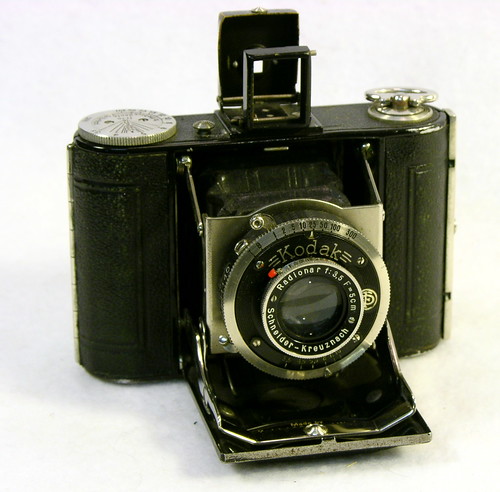Difference between revisions of "Vollenda 48"
m (correcting Collection Appareils link) |
m (link to 127 film) |
||
| Line 4: | Line 4: | ||
|image= http://farm3.static.flickr.com/2700/4364172812_baeaa0d121.jpg | |image= http://farm3.static.flickr.com/2700/4364172812_baeaa0d121.jpg | ||
|image_align= right | |image_align= right | ||
| − | |image_text= Vollenda for 127 film; Radionar lens version | + | |image_text= Kodak branded Vollenda for 127 film; Radionar lens version |
|image_by= Mark O'Brien | |image_by= Mark O'Brien | ||
|image_rights= with permission | |image_rights= with permission | ||
}} | }} | ||
| − | While there was a [[Kodak Vollenda 620|Vollenda 620]], the best known Vollenda is the 3×4cm format '''Vollenda 48'''. It was a very compact folding camera making 16 exposures on the 127 film. | + | While there was a [[Kodak Vollenda 620|Vollenda 620]], the best known Vollenda is the 3×4cm format '''Vollenda 48'''. It was a very compact folding camera making 16 exposures on the [[127 film]]. |
It existed with a folding frame finder or a folding optical finder. | It existed with a folding frame finder or a folding optical finder. | ||
Revision as of 17:04, 29 March 2012
The Vollenda was a line of models made by Nagel, later Kodak AG. The camera series was launched in 1929.

|
| Kodak branded Vollenda for 127 film; Radionar lens version image by Mark O'Brien (Image rights) |
While there was a Vollenda 620, the best known Vollenda is the 3×4cm format Vollenda 48. It was a very compact folding camera making 16 exposures on the 127 film. It existed with a folding frame finder or a folding optical finder.
The lens and shutter combinations included:
- Schneider Radionar 5cm f:4.5 with Pronto 25-100
- Schneider Radionar 5cm f:3.5 with Compur 300
- Schneider Radionar 5cm f:3.5 with Compur-Rapid 500
- Schneider Xenar 5cm f:3.5 with Compur 300
- Carl Zeiss Jena Tessar 5cm f:3.5 with Compur 300
- Leitz Elmar 5cm f:3.5 with Compur 300
- Schneider Xenar 5cm f:2.9 with Compur 300
- Carl Zeiss Jena Tessar 5cm f:2.8 with Compur 300
The cheapest ones had front cell focusing, the most expensive had helical focusing.
At the same time, Nagel was manufacturing the Pupille, a 3×4cm rigid camera that was a more expensive alternative to the Vollenda.
Links
- Vollenda 48 at Mike Elek's camera site [1]
- list of Vollenda types at ukcamera.com [2]
- Vollenda 620 manual on Mike Butkus's Manual site
- Vollenda with Kodak lens @ www.orphancameras.com
- Vollenda at Sylvain Halgand's www.collection-appareils.fr